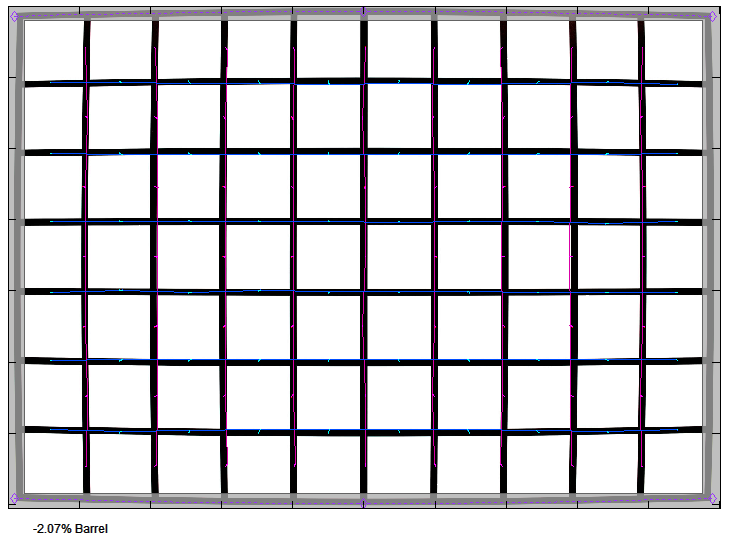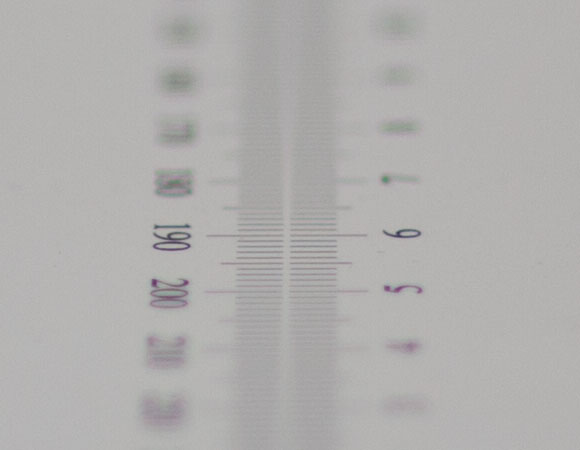|
Samyang 50mm T/1.5 AS UMC CINE DS (Samyang 50mm f/1.4 AS UMC) - Review / Lab Test - Analysis |
|
Lens Reviews -
Canon EOS (Full Format)
|
|
Page 2 of 2

Distortion
We have seen it fairly often with other Samyang lenses - the distortion characteristic is somewhat below average for a lens in this class. A barrel distortion of 2% isn't drastic but it can be visible in certain scenes.

Vignetting
The vignetting is generally well controlled for a full format lens. At fully open aperture there is some visible light falloff (~1.7EV) but we have seen worse results from other ultra large aperture lenses. At T/2 (thus roughly f/2) the issue is greatly reduced and not relevant anymore beyond.

MTF (resolution)
As a rule of the thumbs, Samyang lenses are/were usually optimized for resolution at the expense of distortions. Is this also true here ? Well, only partially. The center quality is indeed very decent with an already fairly sharp and contrasty result at T/1.5. The borders and, more so, the corners fall behind with just fair to good quality though. Stopping down to T/2 and T/2.8 improves the results gradually. At T/4 there's a final boost in the image center which reaches outstanding levels here. The border/corner quality achieves its very good peak fairly "late" around T/5.6. There's a slight degree of field curvature but this should remain unnoticeable in most situations.
The centering quality of the tested sample was good.
Please note that the MTF results are not directly comparable across the different systems!
Below is a simplified summary of the formal findings. The chart shows line widths per picture height (LW/PH) which can be taken as a measure for sharpness.
If you want to know more about the MTF50 figures you may check out the corresponding Imatest Explanations

Chromatic Aberrations (CAs)
Lateral chromatic aberrations (color shadows at hard contrast transitions) are quite unobtrusive with an average pixel width of less than 0.9px at the image corners.

Bokeh
Regarding its ultra large aperture nature, it's also interesting to have a look at the bokeh (quality of the out-of-focus blur) of the Samyang lens. Unfortunately the results are rather mixed in this chapter.
The smoothness of the general blur is decent - both in the back- and foreground.
 However, a real weakness is the rendition of out-of-focus highlights. As you can see in the sample crops below, they have a double halo at max aperture - almost like the results from mirror lenses . It seems as if Samyang didn't really take the effect of the aspherical elements into account during the design phase. As so often, the shape of the highlights does also deteriorate towards the image corners. Closing the aperture helps to mask the outer halo and improves the "cat's eyes" in the corners. However, usually you are really after nicely rendered highlights at T/1.5, not T/2. The more edgy aperture shape is also getting more apparent from T/2.8 onward.
However, a real weakness is the rendition of out-of-focus highlights. As you can see in the sample crops below, they have a double halo at max aperture - almost like the results from mirror lenses . It seems as if Samyang didn't really take the effect of the aspherical elements into account during the design phase. As so often, the shape of the highlights does also deteriorate towards the image corners. Closing the aperture helps to mask the outer halo and improves the "cat's eyes" in the corners. However, usually you are really after nicely rendered highlights at T/1.5, not T/2. The more edgy aperture shape is also getting more apparent from T/2.8 onward.

Bokeh Fringing
Ultra large aperture lenses are suffer from bohek fringing - thus a green (background) and purple (foreground) color tint in the out-of-focus zones. The Samyang has its (normal) share of fringing effects here. As usual they are mostly gone from f/4 onward.
|
Move the mouse cursor over the f-stop marks below to observe the respective LoCAs
|
| T/1.5 |
T/2 |
T/2.8 |
T/4 |
|

|
VerdictThe Samyang 50mm T/1.5 AS UMC (Samyang 50mm f/1.4 AS UMC) didn't really thrill us although it is far from being a bad lens. Its optical qualities simply don't stand out enough to make a difference compared to other 50mm lenses. That being said - the image center is quite sharp at max. aperture although the outer image region isn't all that hot here. Stopping down to medium aperture improves the quality especially in the image center and the borders/corners are getting quite snappy from f/2.8 onward. The image distortions are somewhat more pronounced than usual albeit still decent. The vignetting is pretty good for such a kind of lens. However, the biggest weakness is the bokeh - namely out-of-focus highlights - which can be a showstopper in low light scenes when using the lens at T/1.5 (aka f/1.4 here).
The mechanical quality of the Samyang lens is very fine. It may not have been carved from granite but the materials are of good
quality and there are no wobbly parts ... except for the dreadful lens hood.
As mentioned we have tested the CINE variant which offers silky smooth focusing and aperture changes. We expect that the focusing on the conventional version of the lens is almost as good.
For photographic purposes, the Samyang lens makes little sense in our opinion. The Canon EF 50mm f/1.4 USM or the more expensive but
superb Sigma 50mm f/1.4 HSM DG Art are more obvious choices - and both are fully coupled (AF, aperture) with the camera whereas the Samyang is an all-manual lens. The conclusion regarding the CINE version is more difficult when taking the very different requirements from the movie market situation into account. The Samyang (Bower/Rokinon/Walimex) is sold for as little as 450US$ or 550EUR. For comparison - the Canon 50mm T/1.3 or Zeiss 50mm T/1.5 cost about a 10 fold ... a difference which may let mortal movie makers forgive the few shortcomings of the Samyang actually.
|